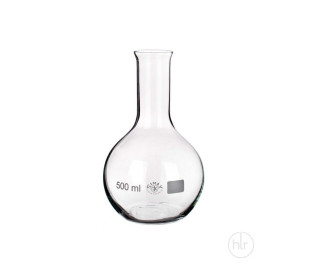Flat bottom flask
Flat Bottom Flask - Self-Standing Laboratory Glassware
Walk into any working lab and you'll spot flat bottom flasks lined up on benches, ready for action. The defining feature here is practical simplicity—that flat base means you can set it down anywhere without hunting for ring stands or clamps. Made from borosilicate 3.3 glass that handles thermal shock up to 500°C, these flasks bridge the gap between everyday storage and active heating applications.
Stable Base Design for Benchtop Applications
The flat bottom gives you positioning options that round bottom flasks can't match. You can place these directly on hot plates for gentle heating without needing specialized mantles. Compare this to round bottom flasks or laboratory boiling flasks, which require support hardware even when you're just mixing at room temperature. For reflux setups or distillations where you need extended heating, round bottoms distribute heat more evenly—but for quick warming or simple reactions, flat bottoms win on convenience. Temperature distribution isn't as uniform as spherical designs, so watch your heat settings to avoid hot spots during prolonged heating.
Self-Standing Convenience Features
- No support equipment needed: Sits stable during reagent addition, stirring, or observation periods
- Direct hot plate compatibility: Place on heating surfaces without adapters, though heating mantles work too
- Standard ground glass joints: Available with socket connections like Flat Bottom Flask with socket for attaching condensers or thermometer adapters
- Volume graduations: Quick visual checks without transferring to graduated cylinders
Mixing and Storage Capabilities
Magnetic stirring works beautifully in flat bottoms since the stir bar sits flush against the base—no wobbling like you'd get with round-bottom flask with socket models. The narrow neck minimizes solvent evaporation during extended mixing. Capacities from 25ml to 5000ml cover everything from test batches to pilot-scale preparations. Single-neck versions handle straightforward reactions, while multi-neck configurations let you add reagents under inert atmosphere. For titrations or pH monitoring, consider conical flask with a wide throat instead—the wider opening makes electrode insertion easier.
Compatible Stopper and Closure Options
Joint sizes follow standard tapers: 14/20 for smaller volumes, 19/22 and 24/29 for mid-range work, and 29/32 for larger flasks. Rubber stoppers work for short-term storage, but ground glass stoppers prevent solvent creep during overnight setups. Thread-on GL caps with PTFE liners seal better for volatile organics. Match your joint size to existing glassware—mixing 19/22 and 24/29 equipment means hunting for adapters mid-procedure.
Our partners
We only work with trusted brands
Sign up to our newsletter to get the latest news and updates about our products.







